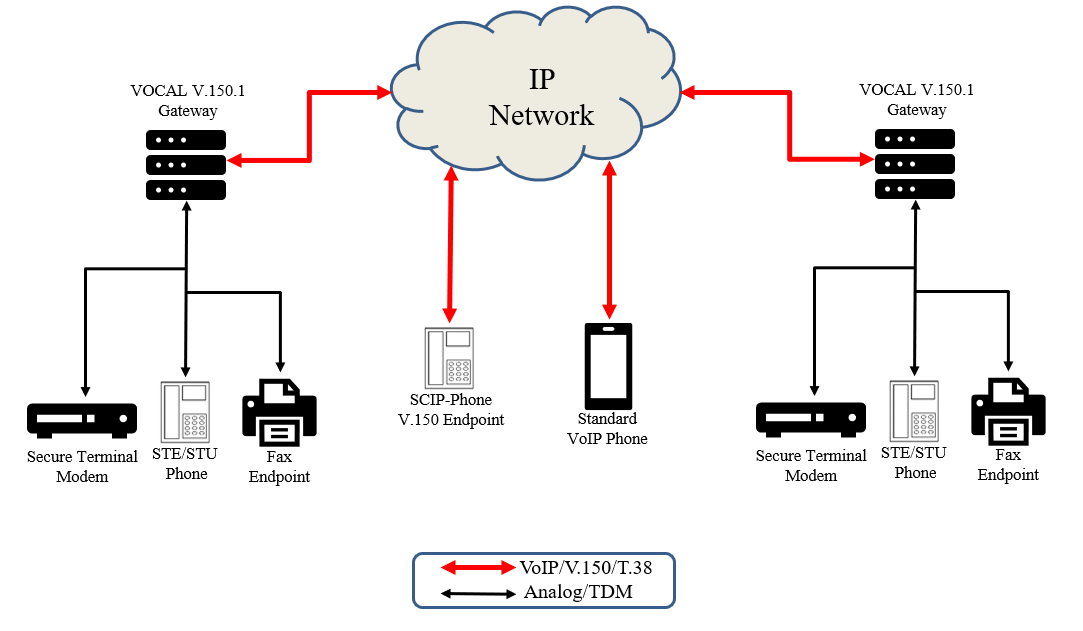V.150.1 Gateway
 VOCAL’s V.150.1 Gateway is a standards based implementation that incorporates reliable and efficient transport of any type of modem signal across IP networks by using Simple Packet Relay Protocol (SPRT). This solution supports modem over IP (MoIP) operation in Voice Band Data (VBD) and Modem Relay (MR) mode.
VOCAL’s V.150.1 Gateway is a standards based implementation that incorporates reliable and efficient transport of any type of modem signal across IP networks by using Simple Packet Relay Protocol (SPRT). This solution supports modem over IP (MoIP) operation in Voice Band Data (VBD) and Modem Relay (MR) mode.
VOCAL’s V.150.1 endpoint /terminal is MoIP termination solution that combines a VOCAL SIP Analog Modem Server (SAMS) and the VOCAL V.150.1 gateway. It is compliant with ITU-T V.150.1 recommendations. The virtual modem servers can get to the IP network via the V.150.1 gateways and talk to any physical modem behind a PSTN connection on the other side. It has all the features of the VOCAL SAMS or a hardware modem. Our implementation also provides a methodology for internetworking between newer IP based instruments and legacy devices.
Sectéra®, TalkSECURE™, and vIPer™ are trademarks of General Dynamics.
Features
SSE – Signaling State Events are supported; a mechanism by which the media states are synchronized between the media gateways.
SPRT – Simple Packet Relay Transport for modem relay is supported along with different data types (I_OCTET, I_OCTET_CS, I_RAW_OCTET) to carry the modem data from one gateway to another.
SDP – Variations of session description, based on requirement – e.g. port sharing so that SPRT and RTP can be sent over the same port.
Scalability – A large number of channels on a single gateway can be supported, ranging from 10s to 100s, based on the gateway resources and modem rates.
Flexibility – VOCAL’s V.150.1 Gateway is based on a hardware independent library, allowing for a large number of the target platforms. Any standard Linux or Windows distribution is supported, along with a wide variety of embedded platforms.
Benefits
- Digital control messages replace analog tones, for successful traversal of packet networks.
- Supported data modulations include V.34, V.32, V.32bis, V.22bis, V.22, V.21, V.23, V.90, V.91 and V.92 modem standards as well as standard fax modulations.
- Fully interoperable with all major vendors.
- Eliminates extra trunking by converging data, voice, and fax.
- Interconnection of multiple communications networks, such as wireless, wired PSTN, and IP networks, is an important capability for the defense system.
- Standard for enabling the use of secure telephones over IP networks. The newest generation of SCIP-over-IP telephones (vIPer™, VoIP STE) use IP relay techniques, eliminating the carrier layer.
- Telemetry application transport over IP-based networks can give reliable and economic solutions.
Voiceband (VBD) – Audio is encoded by an audio codec such as G.711 and transmitted as data packets over the network. VBD mode may be used over reliable networks with predictable throughput and negligible packet loss.
Flexible Implementation:
- Based on decades of experience engineering modems and VoIP telecommunication systems, VOCAL is uniquely capable of creating modem systems that run purely in software, or on your custom hardware system, and interfacing with your customized interfaces and specialized applications. Whether your modems are on one or both ends of the network, VOCAL has a safe and reliable solution.
- VOCAL’s systems are ITU-T and IETF standards based and fully compatible, so replacing an existing V.150.1 gateway will happen seamlessly. Variations include communication with both gateways or standalone endpoints that send V.150.1 messages directly on the IP link.
- VOCAL’s V.150.1 implementation adheres to the Secure Communication Interoperability Protocol (SCIP-216 Rev 2.2). Our V.150.1 End-Terminal software uses V.150.1 directly, to communicates with a modem located on the PSTN via a V.150.1 gateway.

VOCAL’s solution is available for the above platforms. Please contact us for specific supported platforms.

Please contact us for more information about our V.150.1 Gateway Solution.